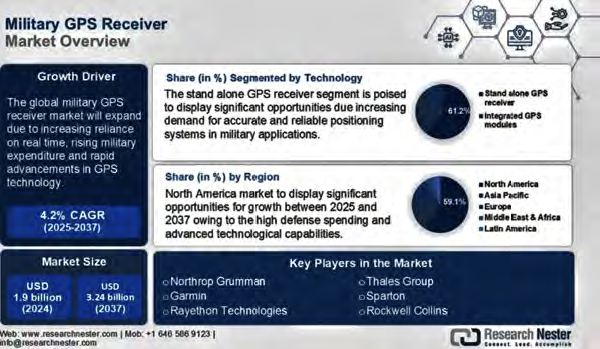Asshi Mishra, Senior Content Writer, Research Nester
The rising tensions between global powers is leading to an unprecedented surge in military spending—the International Institute for Strategic Studies stated that defense spending across the globe reached $2.46 trillion in 2024.

Countries are integrating the latest technological advancements within their military operations. One such technological boon is GPS... no less than the crucial backbone for modern defense.
Global positioning systems (GPS) have become a vital military tool in today’s hostile arenas as it can offer three-dimensional positioning, navigation, and timing (PNT) data. Beyond the everyday applications of GPS for navigation, these systems enable tracking military assets, in real-time, from any location in the world.
 Military GPS receivers are specialist navigational aids made for use in military settings. Their powers and features include better security, anti-jamming capability, selective availability anti-spoofing modules (SAASM), high precision, anti-spoofing and anti-jamming antennas.
Military GPS receivers are specialist navigational aids made for use in military settings. Their powers and features include better security, anti-jamming capability, selective availability anti-spoofing modules (SAASM), high precision, anti-spoofing and anti-jamming antennas.
Due to numerous, pervasive, hostile scenarios around the world, the use of military GPS receivers is rapidly increasing to enable precise positioning and navigation for a variety of operational tasks. Moreover, these receivers continue to increase in number in response to the global rise in various border disputes as well as terrorist threats. With advancements in satellite technology and cybersecurity, military GPS receivers are evolving to meet the demands of contemporary warfare.
Leading companies that are engaged in the MILSATCOM environs are garnering enviable profits and rendering excellent services to their client bases A few of the GPS applications include...
1. Navigation and Guidance
GPS offers versatile, effective, and incredibly dependable navigation and guidance options to military personnel worldwide. In times of war and peace, GPS serves as the main navigation system for soldiers, vehicles, ships, and aircraft.
For instance, more than three billion global navigation satellite system across the globe depend on the GPS signals that supplied by the U.S. Space Force’s satellites. This has increased the demand for advanced GPS receivers with high accuracy and reliability. These receivers are now essential to military forces because they make precise digital mapping options available, and enable communication in critical missions.
Likewise, unmanned systems, such as UAS, UAV, and UGV, are used in a variety of military and defense applications where GPS/GNSS is necessary to always know the exact location of the device... and those being tracked. The United States has the largest military drone fleet in the world, with more than 12,000 UAVs.
Jamming and GPS spoofing are two of the most prevalent cyberattacks on UAVs that cause them to become ineffective. As accurate and unobstructed position data is essential for the safe operation of GPS-dependent UAVs, developing and manufacturing high-end GNSS and GPS receivers is indispensable to organizations. Receivers built to deny cyberattacks use spoofing detection and mitigation techniques to create highly effective defense strategies.
2. Surveillance and Reconnaissance
Reconnaissance and surveillance information includes data on the terrain, weather as well as threats that are vital information for all military operations. The importance of intelligence, surveillance, and reconnaissance (ISR) capabilities to the military is no longer a ‘nice to have’ but ‘have to have’ in order for GPS-guided UAVs to provide command centers and warfighters with battlefield situational awareness (BSA).
 In January of 2025, Ukraine’s Ministry of Defense announced the adoption and deployment of the Poseidon H10 MkIII, a domestically developed UAV system, that represents a significant advancement in the Ukrainian Armed Forces’ capacity for surveillance and reconnaissance.
In January of 2025, Ukraine’s Ministry of Defense announced the adoption and deployment of the Poseidon H10 MkIII, a domestically developed UAV system, that represents a significant advancement in the Ukrainian Armed Forces’ capacity for surveillance and reconnaissance.
A vital role that unmanned systems play in contemporary warfare and surveillance operations throughout the seemingly continuous war cannot be understated. GPS receivers are essential for ISR to track enemy movements, and enhance BSA.
3. Target Acquisition and Tracking
Tracking and detecting targets is a crucial mission of military operations for the recognition of signs and indications that reveal the presence of target(s) in certain locations. GPS is used by military weapon systems to track air and ground targets that encompass enemy vehicles, aircraft, or individuals.
In July of 2024, the Air Force Research Laboratory (AFRL) in U.S. announced the introduction of new target-tracking capabilities that use Artificial Intelligence (AI) and other cutting-edge technologies that are being developed for the offensive and defensive architectures of the future.
The AFRL is also seeking tools to assist with the ingestion and processing of telematic-based data that is provided by GPS, non-GPS, inertial navigation systems, or radio frequency (RF) identification trackers.
GPS receivers are essential for target acquisition and tracking systems. These systems aid in precisely locating adversary assets and positions.
By the close of 2037, the military GPS receiver market is expected to have grown from a 2024 valuation of $1.9 billion to $3.2 billion. Growing geopolitical tensions and conflicts are major factors driving the military GPS receiver market.
Geopolitical threats do affect the world’s economy, leading to an increased focus on minimizing collateral damage and enhancing mission effectiveness. Moreover, the growing use of autonomous systems, such as drones, unmanned land vehicles, and unmanned underwater vehicles (UUV), has increased the adoption of GPS receivers for precise positioning and navigation.
Major companies in the military GPS receiver market are continuously inventing and creating more precise, dependable and user-friendly products. They are also investing in R&D to boost the accuracy and reliability of their navigation skills. Leading corporations that include BAE Systems, Raytheon Technologies Corporation, Mayflower Communications, and General Dynamics Corporation, have gained a major share of this market segment.
In May of 2022, Mayflower Communications Company Inc. obtained approval from the U.S. Federal Aviation Administration (FAA) for both models of that company’s MAGNA GPS anti-jam product that provides simultaneous L1/L2 protection and are capable of safeguarding both military and commercial GPS receivers.
Today, the military GPS receiver market is dominated by the U.S., and this trend is expected to continue. The growth of the market in this region can be attributed to increased defense spending and the growing need for cutting-edge military technologies.
 Featuring extra ordinary capabilities, today’s GPS is a foundation of contemporary military operations. As many military missions and operations significantly depend on the transmission of real-time data, the use of military GPS receivers is increasing, and will continue to grow, to offer precise target tracking and route guidance.
Featuring extra ordinary capabilities, today’s GPS is a foundation of contemporary military operations. As many military missions and operations significantly depend on the transmission of real-time data, the use of military GPS receivers is increasing, and will continue to grow, to offer precise target tracking and route guidance.
To obtain a competitive advantage, major companies in the military GPS receiver market are continuously concentrating on creating more precise, dependable, and user-friendly products. Toward that end, GPS receivers are now an essential part of military forces and their usage is likely to accelerate in recent years.
www.researchnester.com/reports/military-gps-receiver-market/7134

